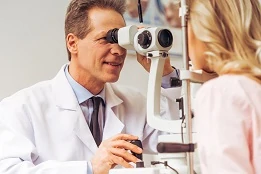Nearsighted? Answers to Questions About Myopia – A Common Vision Problem

Are you nearsighted? Do you have difficulty seeing things clearly in the distance such as street signs or maybe the TV across the room? You’re not alone. It is called myopia and it is a common eyesight condition affecting people of all ages. To help better understand nearsightedness, we’ve answered the questions people frequently ask.
Q: What is myopia or nearsightedness?
A: Nearsightedness, also known as myopia, is a refractive error, meaning the eye is unable to focus light correctly. For people who are nearsighted, objects in the distance are blurred, but objects that are nearby are clearly visible.
In a normally shaped eye, light rays enter the eye and pass through the cornea and lens, which direct it onto the retina at the back of the eye. This creates a crisp, clear image that is sent to the brain.
Nearsightedness occurs when the eyeball grows too long, or the cornea is not evenly curved. As a result, light rays focus in front of the retina instead of directly on it and the image sent to the brain is blurred.
Nearsighted people can correct their vision by wearing prescription eyeglasses, contact lenses, or having a vision correction procedure such as LASIK, SMILE, PRK, or ICL.
Q: How common a condition is nearsightedness?
A: A recent study estimated that 30 to 40 percent of adults in the United States are nearsighted. Experts predict the number of people with myopia will continue to increase, eventually becoming a global epidemic impacting the vision of nearly half the world’s population by 2050.
Q: What causes nearsightedness?
A: While scientists don’t know the exact causes of nearsightedness. Some contributing factors that may prevent normal development of the eye include:
- Genetics. Nearsightedness often runs in families.
- Eyestrain. Spending long periods focusing your eyes on nearby objects such as books, computer screens, and hand-held devices including cell phones and tablets.
- Lifestyle. Not spending enough time outdoors where light levels are much brighter and the tendency is to look out over a variety of distances.
Q: What are the symptoms?
A: The most common symptoms of nearsightedness include tired eyes/eye strain, headaches, squinting, rubbing eyes, poor vision at night, and difficulties seeing objects far away.
Q: When do nearsighted symptoms start appearing?
A: Nearsightedness usually develops during childhood and the teenage years. Adults also can develop nearsightedness, usually from visual stress or health conditions.
Q: How is nearsightedness diagnosed?
A: You can find out if you are nearsighted by having a comprehensive eye exam. During the exam, your eye doctor will measure the power of your eyes using various refraction techniques – including the common eye chart. The phoropter or autorefractor device measures the actual degree of nearsightedness in diopters. The higher the number, the more nearsighted you are:
- Mild myopia includes prescriptions up to -3.00D (diopters). People in this range have difficulty seeing the lines of small letters on the eye chart.
- Moderate myopia, values of -3.00 to -6.00D. In this range, people can only see the large letters on the eye chart.
- High myopia is usually myopia over -6.00D. These people often cannot clearly see the big E on the eye chart.
Q: Can LASIK or other vision correction procedures correct nearsightedness?
A: Yes. LASIK is the most common laser vision correction procedure used to correct nearsightedness. However, depending upon candidacy and prescription, ICL, SMILE and PRK are options for treating nearsighted patients.
Q: How does vision correction treat nearsightedness?
A: Laser vision correction treat nearsightedness by using laser technology to precisely reshape the cornea to improve the eye’s ability to focus light onto the retina. ICL inserts a clear lens in the eye to improve the focusing power.
Q: What is the recovery like for vision correction?
A: Most patients have a short recovery time after LASIK, SMILE, and ICL can resume many normal activities within a day or two. Their vision will usually start to improve within a few hours or days, although it may not fully stabilize for up to a month. PRK requires several days of recovery and the healing period takes a little longer, typically lasting 3-6 months.
Q: What will my vision be like after vision correction?
A: Most patients will notice a dramatic improvement in their vision right away. For others, it may take a couple of days or weeks. The latest research found that 99 percent of patients achieve better than 20/40 vision after LASIK and more than 90 percent achieve 20/20 or better. Nearly 100 percent of patients achieve 20/20 vision with ICLs.
Q: Is laser vision correction for nearsightedness permanent?
A: Laser vision correction treats the vision prescription you have at the time of the procedure. The reshaping of the cornea to correct for nearsightedness is permanent. However, everyone’s vision changes over time, and conditions that were corrected with laser vision correction – including nearsightedness – can return. Other eye conditions that may cause your vision to change significantly after laser vision correction include cataracts and glaucoma. Also, laser vision correction does not prevent the natural aging of the eye (called presbyopia). You will likely need glasses to read once you reach your mid-forties when the lens of the eye loses its ability to focus on objects nearby.
Q: Who is a candidate for vision correction procedures?
A: Adults who have reached ocular maturity (typically after 20 years of age when eyes stop physically developing); have a stable prescription that hasn’t changed in over a year; have healthy corneas and are in good general health, are typically good candidates for LASIK, SMILE, PRK or ICL procedure.
Q: Who is not a candidate for laser vision correction?
A: People who do not have a stable prescription; have thin or irregular corneas or eye diseases like glaucoma; have autoimmune diseases like lupus or rheumatoid arthritis; are not in good health and/or take certain prescription medications such as corticosteroids (which can impair the healing process); or are pregnant or nursing, are not good candidates for laser vision correction. However, there are other vision correction procedures, including ICL and refractive lens exchange, which may be a good alternative.
Q: What is the cost of vision correction surgery?
A: The national average price for LASIK and SMILE is approximately $4,400 for both eyes. PRK is typically less. ICLs are about $4,400 per eye. Ask if the price you are quoted covers the initial consultation, follow-up visits, and any extra treatment you may need. Learn more about the cost of LASIK and other vision correction procedures, including insurance benefits, ways to pay, and what to consider.




